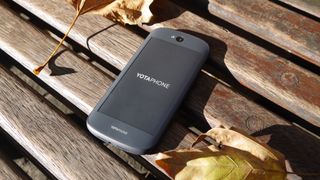Why you can trust TechRadar
Up front
I've focussed heavily on the rear display of the Yotaphone 2 so far for obvious reasons, but that's not the only thing to shout about here.
The 5-inch AMOLED screen on the front isn't just an afterthought, with a full HD resolution and bright, vibrant colours making for an attractive display.
It comfortably stands up against the displays found on the Sony Xperia Z3, Samsung Galaxy S5 and HTC One M8.

It may not be great in direct sunlight, but no phone screen is and the trump card held by the Yotaphone 2 is you can flip it over for a display which doesn't have any trouble in bright light.
In fact, with a slightly smaller display size versus some of its high-end competition, the Yotaphone 2 boasts a pixel density of 442ppi. That's a touch better than the S5 at 432ppi and the Xperia Z3 with 424ppi.
The 5-inch form factor provides enough on-screen real estate without being overbearing in the hand, and you'll be able to comfortably watch movies and play the latest games without issue.
Mirror, mirror
As well as the custom interface Yota Devices has created for its rear facing EPD, the YotaPhone 2 also lets you access the full Android interface from the front screen on the rear display.
It's a feature dubbed YotaMirror and it's super easy to engage. All you need to do is hold and slide up from the home key (the action you use to launch Google Now), but instead of dragging your finger to the Google symbol go left to mirror mode.
Flip the phone over and you'll find the full Android operating system in all its monochrome glory.
Performance is much slower due to the screen technology which needs to redraw every new screen, but it does work.
You won't be playing games or watching movies in this mode, but for updating social media or checking out websites it works well (and a little slowly) and uses less battery in the process.
Life after death
I've already mentioned briefly on the previous page that the EPD stays on even when the phone is off and out of battery.
You can't use the display when out of juice, but it can display a useful image such as a map, address or boarding pass.
The feature is called YotaSnap, and when the phone is on you can store a series of screenshots and images into a small gallery which you'll still be able to access with just a sliver of battery left in the tank.

Let the phone die though and only one will be available - and you can set a default so you don't have to remember to navigate to a particular image just before the phone switches off.
Yota clearly sings the praises of this feature, but in day to day use I found very few occasions where this would be genuinely useful. And that's a feeling I get most of the time when using the rear display - it's innovative, but I'd much rather use the more responsive and easier on the eye colour display most of the time.
Current page: Key features
Prev Page The EPD: Electronic Paper Display Next Page Interface and performance
John joined TechRadar over a decade ago as Staff Writer for Phones, and over the years has built up a vast knowledge of the tech industry. He's interviewed CEOs from some of the world's biggest tech firms, visited their HQs and has appeared on live TV and radio, including Sky News, BBC News, BBC World News, Al Jazeera, LBC and BBC Radio 4. Originally specializing in phones, tablets and wearables, John is now TechRadar's resident automotive expert, reviewing the latest and greatest EVs and PHEVs on the market. John also looks after the day-to-day running of the site.

Is there a moral imperative for businesses to share data?

Why sovereign AI infrastructure is driving worldwide adoption of Generative AI

Real life 6G speed tests revealed by Japanese tech giants — 100Gb/s transmissions could become the norm for mainstream wireless network data transfer within a few years
